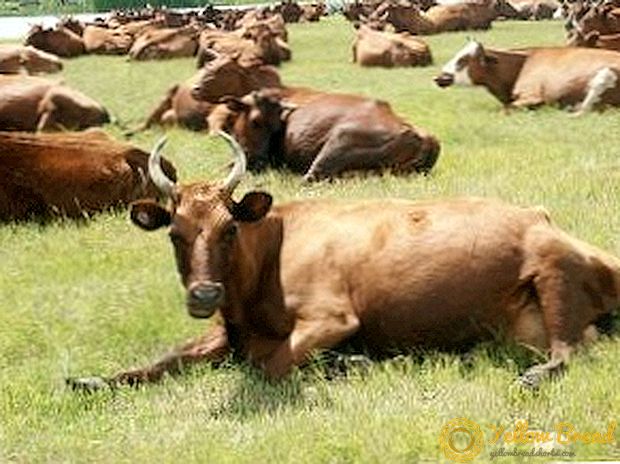
On large dairy farms, often, there is a veterinarian who closely monitors the condition of the animals.
After all, there are diseases that can significantly reduce the number of cows.
It is known that it is better to prevent the disease than to cure it, because a lot of money can go on medicines for livestock.
It is for the prevention of diseases that every spring it is better to carry out the prevention of all animals.
Listed below are the most common diseases of cattle.
Brucellosis

Animals are affected by the bacterium Brucella, which causes the disease.
Brucellosis does not affect a specific organ or weave, but the entire body of an animal, which is what makes this disease terrible. In addition to the defeat of the animal, brucellosis can also be transmitted to humans through foci of infection, mucous membrane and products derived from the cow.
The main cause of this disease is unsanitary conditions. Externally, the disease may not manifest itself, but over time, the defeat can reach the uterus, which leads to abortions and the birth of a dead calf.
In addition to this symptom, there are others, for example, the formation of bursitis on the front legs, and on the hind limbs - a hygroma and an abscess.
Brucellosis occurs in three stages: acute, subacute and chronic.The treatment is performed mainly with antibiotics, but due to asymptomatic brucellosis, animals most often die.
Tuberculosis

This disease is infectious.
The causative agent of tuberculosis is mycobacterium, and of a different type (human, bovine and avian).
This disease is transmitted through already infected animals by airborne droplets, as well as by contact with the affected areas of the mucous membrane. Transmission can occur through general feed, manure, water, bedding, as well as general care items.
Tuberculosis is not visible externally, since he does not give symptoms. The disease mainly affects the lungs and intestines.
If tuberculosis has struck the lungs, then the animal begins to cough strongly, which indicates the damage to the pleura and the lungs themselves. If the intestine is affected, then the cow has bloody diarrhea.
With a widespread lesion, animals lose weight and become weaker, their lymph nodes grow, they eat little.
To detect the presence of Koch sticks in an animal, it is necessary to give bronchial mucus, milk, urine or feces for analysis. If an animal is infected, it must be destroyed in order to prevent infection of healthy cows.As a preventive measure, regular intradermal tuberculinization of the entire population is used.
Foot and mouth disease

This is a viral disease caused by an RNA virus from the family of picornoviruses. It spreads very quickly, the incubation period takes less than 2 weeks.
If the animal is infected with foot and mouth disease, then it has very quickly the temperature risesand transparent bubbles appear on the tongue, lips, udder and nipples.
Viscous frothy saliva is constantly emitted from the mouth. When the bubbles burst, but small ulcers appear in their place.
Foot and mouth disease can be transmitted through feed, in contact with items serviced by cows, as well as by direct contact with ulcers. If the animal is not identified and cured in time, then it may die due to rapid weight loss.
Treatment should be carried out by a veterinarian by injecting antiviral and immunostimulating preparations into the cow’s body. isolate the animal from the main herdand also thoroughly disinfect the place where a sick cow stays.
To prevent infection, you need to vaccinate the entire flock with the appropriate preparationand comply with all sanitary and hygienic standards.
Leukemia

The causative agent of this infection is the bovine leukemia virus. Healthy cows can become infected with leukemia from sick animals.
Leukemia can proceed in two stages: enzootic and sporadic. This disease can affect both adult animals and calves, the only difference is in the form of leukemia.
For example, calves can suffer from thymus and cutaneous leukemia, and adult cattle can suffer from juvenile. In any case, leukemia affects all organs of the animal, forming tumors in different parts of the body.
It is possible to diagnose a disease by means of a blood test. Sick animals impossible to cure, they are immediately sent for slaughter.
To prevent and detect leukemia, all animals from the herd of vaccines should be injected, and timely inspection and inspection of animals for the presence of a virus should be carried out. If a sick animal has been identified, it should be isolated as soon as possible from the rest of the population.
Gastroenteritis

This disease is characteristic of calves who have been transferred from milk to vegetable feed or when fed with poor feed.Most often, animals get sick with gastroenteritis in spring and autumn.
In spring, cows and calves can graze along with grass on the ground and in the fall, when the temperature drops, the chemical composition of the grass changes.
The main signals for the presence of this disease are diarrhea, lack of activity and gum in the animal. Often the animal does not even rise to its feet .
If the calf is sick with gastroenteritis, then it can not be fed 1 - 1.5 days after the detection of the disease. Cattle must be given either a laxative or castor oil in an amount of 50 to 80 ml twice a day.
During the period of illness of the animals need to drink broth flaxseed or oat broth. You can feed the same good hay or oatmeal.
anthrax

The causative agent of this extremely dangerous infectious disease is a fixed bacillus in the form of a rod. Settling in the body, the bacterium secretes spores and capsules that quickly spread throughout the body.
Anthrax can spread directly from the body of a sick animal, as there are a lot of bacilli in the open wounds of this disease. Also, anthrax spores can be found on objects with which a sick animal came in contact, so they should be carefully processed after a disease is detected in a cow.
Anthrax is characterized by seasonality. The boom of infection falls on the summer, when animals spend most of the day on pasture. During the rest of the year, cases of anthrax infection are sporadic.
First, the disease acts secretly, and can manifest itself as a day or three, or several hours after the bacillus enters the body. The characteristic signs of anthrax are jumps in body temperature, disorders of the gastrointestinal tract (intestinal form), the appearance of swelling on the body (carbunculosis form).
Common signs are a decrease in milk yield, cessation of gum, a reddish hue of milk, and milk is also stratified into flakes.
For treatment, a special serum is used, which activates the immune system. Preventive measures consist in isolating sick animals in the event of infection, as well as in disinfecting all the premises and changing pastures.
Mastitis

This bacterial disease causes inflammation of the mammary glands in cows. Mastitis is most common in young cows who have just begun to be milked.
The main factors that cause mastitis are unsanitary conditions, the wrong milking technique. The presence of mastitis can be determined by milk.
If there are protein flakes in a cow, then this is the main symptom of the disease. Also during mastitis, the udder swells, its temperature rises, and the cow becomes weak and lethargic.
To treat mastitis you need antibiotics that will kill all the bacteria that are the causative agents of mastitis. To prevent the appearance of the disease, each time before milking, the udder must be wiped with a cloth dipped in warm water.
Dyspepsia

This disease is characteristic of calves. There is dyspepsia due to improper feeding of the young, and can also be transmitted from a cow-mother who is sick with mastitis.
There are two forms of dyspepsia: simple and toxic. In the first case, the animal looks depressed, eats poorly, almost does not get up on its feet, and also tries to kick its stomach.
A few days after the first signs of a calf diarrhea begins.
Toxic dyspepsia most often occurs in newborn calves. At the same time, the animal stops eating altogether, becomes weak, and the body temperature drops. After some time, the animal begins to have diarrhea.
It is more difficult to cure this form of dyspepsia, and the prognosis is much worse than in the case of simply dyspepsia.During treatment, you need to fill the lack of trace elements, which was caused by diarrhea. Therefore, calves should solder salt solutions, and also to give vitamin solutions.
Antibiotics should also be given to animals. Prevention consists in observing the rules of colostrum feeding calves, as well as in maintaining sanitary conditions.
Esophagus occlusion

Cows get this type of disorder due to eating root vegetables. When an esophagus is clogged in an animal, the animal first looks frightened, lowers its head, stretches its neck, and saliva copiously secretes.
After you can see that the left scar is swelling up, the swelling increases sharply. You may notice that the animal often breathes, and the heartbeat is very frequent. There are signs of choking. Therefore, while ignoring the blockage, the animal may simply suffocate.
Root can get stuck in the upper and lower esophagus. In the first case, the root crop can simply be reached by hand, and in the second, you need to use a rubber hose, which will push the root crop further into the stomach.
First of all, you need to give the cow a drink of vegetable oil to reduce friction.To prevent blockage, before feeding, the roots need to be crushed, and also not to remove animals to graze where they grew potatoes, cabbage or beets.
Monitor the condition of your cow in order to notice and cure a possible illness in time. Otherwise, some diseases can not only take the life of your animal, but also hit you.






